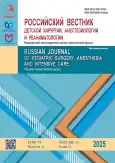Применение шкал полиорганной дисфункции у детей в клинической практике: нужны ли они врачу?
- Авторы: Миронов П.И.1, Александрович Ю.С.2, Степаненко С.М.3, Пшениснов К.В.2, Трембач А.В.4
-
Учреждения:
- Башкирский государственный медицинский университет
- Санкт-Петербургский государственный педиатрический медицинский университет
- Российский национальный исследовательский медицинский университет им. Н.И. Пирогова
- Кубанский государственный медицинский университет
- Выпуск: Том 15, № 2 (2025)
- Страницы: 173-180
- Раздел: Оригинальные исследования
- URL: https://journal-vniispk.ru/2219-4061/article/view/312999
- DOI: https://doi.org/10.17816/psaic1889
- EDN: https://elibrary.ru/BHJGSF
- ID: 312999
Цитировать
Полный текст
Аннотация
Обоснование. Анализ данных литературы свидетельствует об отсутствии публикаций, посвященных анализу мнения врачей — анестезиологов-реаниматологов педиатрических отделений реанимации и интенсивной терапии о необходимости применения шкал оценки тяжести органной дисфункции у детей в клинической практике.
Цель — проанализировать мнение врачей — анестезиологов-реаниматологов педиатрических отделений анестезиологии, реанимации и интенсивной терапии Российской Федерации о необходимости применения шкал оценки степени выраженности полиорганной недостаточности в клинической практике.
Материалы и методы. Дизайн исследования — обсервационное, неконтролирумое, на основе добровольного анонимного анкетирования с использованием ресурсов сайта ассоциации детских анестезиологов-реаниматологов России. Описательные характеристики выражены в виде частот и процентов, ответы на открытые вопросы были сгруппированы по основным качественным параметрам. Сравнительный анализ качественных данных проводили с использованием критерия χ2 Пирсона.
Результаты. В опросе приняли участие 230 респондентов, в подавляющем большинстве это врачи областных клинических больниц (38,7%) и специалисты со стажем более 10 лет (69,6%). Наиболее известными и используемыми были оценочные системы qSOFA, nSOFA, NEOMOD, pSOFA и Phoenix Sepsis score. Регулярно использовали шкалы оценки тяжести полиорганной недостаточности 77 (33,5%) респондентов, максимально востребованной является не валидизированная в отечественных условиях шкала qSOFA.
Заключение. Более 60% детских анестезиологов-реаниматологов нерегулярно используют шкалы оценки полиорганной дисфункции, и основанием для их применения чаще всего становится не определение дальнейшей тактики лечения, а высокий риск летального исхода.
Ключевые слова
Полный текст
Открыть статью на сайте журналаОб авторах
Петр Иванович Миронов
Башкирский государственный медицинский университет
Автор, ответственный за переписку.
Email: mironovpi@mail.ru
ORCID iD: 0000-0002-9016-9461
SPIN-код: 5617-6616
д-р мед. наук, профессор
Россия, УфаЮрий Станиславович Александрович
Санкт-Петербургский государственный педиатрический медицинский университет
Email: jalex1963@mail.ru
ORCID iD: 0000-0002-2131-4813
SPIN-код: 2225-1630
д-р мед. наук, профессор
Россия, Санкт-ПетербургСергей Михайлович Степаненко
Российский национальный исследовательский медицинский университет им. Н.И. Пирогова
Email: steven54@mail.ru
ORCID iD: 0000-0001-5985-4869
SPIN-код: 1046-9206
д-р мед. наук, профессор
Россия, МоскваКонстантин Викторович Пшениснов
Санкт-Петербургский государственный педиатрический медицинский университет
Email: Psh_K@mail.ru
ORCID iD: 0000-0003-1113-5296
SPIN-код: 8423-4294
д-р мед. наук, доцент
Россия, Санкт-ПетербургАнтон Владимирович Трембач
Кубанский государственный медицинский университет
Email: trembach@bk.ru
ORCID iD: 0000-0002-4968-5296
SPIN-код: 4396-6261
Россия, Краснодар
Список литературы
- Cohen IB. Florence nightingale. Sci Am. 1984;250(3):128–137. doi: 10.1038/scientificamerican0384-128
- Karimi H, Masoudi Alavi N. Florence nightingale: The mother of nursing. Nurs Midwifery Stud. 2015;4(2):29475. doi: 10.17795/nmsjournal29475
- Alexandrovich YS, Gordeev VI. Evaluation and prognostic scales in critical care medicine. Saint Petersburg: Sotis; 2020. 320 p. (In Russ.)
- Vincent J-L, Moreno R. Clinical review: scoring systems in the critically ill. Crit Care. 2010;14(2):207. doi: 10.1186/cc8204
- Schlapbach LJ, Straney L, Bellomo R, et al. Prognostic accuracy of age-adapted SOFA, SIRS, PELOD-2, and qSOFA for in-hospital mortality among children with suspected infection admitted to the intensive care unit. Int Care Med. 2018;44(2):179–188. doi: 10.1007/s00134-017-5021-8
- Weiss SL, Fitzgerald JC, Pappachan J, et al. Global epidemiology of pediatric severe sepsis: the sepsis prevalence, outcomes, and therapies study. Am J Respir Crit Care Med. 2015;191(10):1147–115. doi: 10.1164/rccm.201412-2323OC
- Schlapbach LJ, Watson RS, Sorce LR, et al. International consensus criteria for pediatric sepsis and septic shock. JAMA. 2024;331(8):665–674. doi: 10.1001/jama.2024.017914
- Hikmet N, Chen SK. An investigation into low mail survey response rates of information technology users in health care organizations. Int J Med Inform. 2003;72(1-3):29–34. doi: 10.1016/j.ijmedinf.2003.09.002
- Romaine ST, Potter J, Khanijau A, et al. Accuracy of a modified qSOFA score for predicting critical care admission in febrile children. Pediatrics. 2020;146(4):e20200782. doi: 10.1542/peds.2020-0782
- van Nassau SC, van Beek RH, Driessen GJ, et al. Translating sepsis-3 criteria in children: prognostic accuracy of age-adjusted quick SOFA score in children visiting the emergency department with suspected bacterial infection. Front Pediatr. 2018;6:266. doi: 10.3389/fped.2018.00266
Дополнительные файлы








